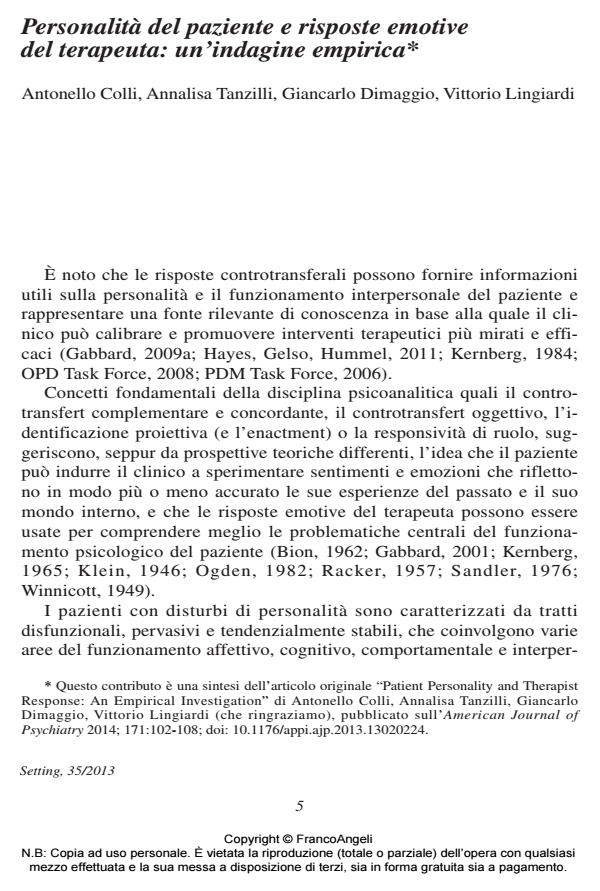Personalità del paziente e risposte emotive del terapeuta: un’indagine empirica
Journal title SETTING
Author/s Antonello Colli, Annalisa Tanzilli, Giancarlo Dimaggio, Vittorio Lingiardi
Publishing Year 2014 Issue 2013/35 Language Italian
Pages 9 P. 5-13 File size 69 KB
DOI 10.3280/SET2013-035001
DOI is like a bar code for intellectual property: to have more infomation
click here
Below, you can see the article first page
If you want to buy this article in PDF format, you can do it, following the instructions to buy download credits

FrancoAngeli is member of Publishers International Linking Association, Inc (PILA), a not-for-profit association which run the CrossRef service enabling links to and from online scholarly content.
The article shows the results of an empirical study on the relationship between patients’ pathology and level of psychological functioning and therapists’ emotional responses. A random Italian sample of 203 psychiatrists and clinical psychologists (some of our associated members too) completed the "Therapist Response Questionnaire" (TRQ; Zittel Conklin, Westen, 2003) to identify patterns of therapists’ emotional response, and Shedler-Westen Assessment Procedure-200 (SWAP-200; Westen, Shedler, 1999; Shedler, Westen, 2007; Shedler, Westen, Lingiardi, 2014) to assess personality disorders and level of psychological functioning in a patient currently in their care. The study showed significant and specific relationships between therapists’ responses and patients’ personality pathology (e.g.: between borderline personality and overwhelmed/disorganized, helpless/inadequate, and special/overinvolved countertransferences; or narcisistic personality and disengaged countertransference, and so on). In general, therapists’ stronger negative feelings were associated with lower-functioning patients.
- http://www.psychsystems.net/Manuals/Countertransference/Westen%20countertransference%
- 20questionnaire.pdf.
- Bateman A.W., Fonagy P. (2006), Mentalization based treatment for borderline personality disorder: A practical guide, Oxford University Press, Oxford, UK, DOI: 10.1093/med/9780198570905.001.0001
- Betan E., Heim A.K., Zittel Conklin C., Westen D. (2005), “Countertransference phenomena and personality pathology in clinical practice: An empirical investigation”, American Journal of Psychiatry, 162: 890-898, DOI: 10.1176/appi.ajp.162.5.890
- Bion W.R. (1962), Apprendere dall’esperienza. Tr. it. Armando, Roma, 1972.
- Bourke M.E., Grenyer B.F.S. (2010), “Psychotherapists’ response to borderline personality disorder: a core conflictual relationship theme analysis”, Psychotherapy Research, 20: 680-691, DOI: 10.1080/10503307.2010.504242
- Brody F., Farber B. (1996), “The effects of therapist experience and patient diagnosis on countertransference”, Psychotherapy, 33: 372-380, DOI: 10.1037/0033-3204.33.3.372
- Clarkin J.F., Yeomans F.E., Kernberg O.F. (2006), Psychotherapy for borderline personality: focusing on object relations, American Psychiatric Publishing, Washington, DC.
- Dahl H.S.J., Røssberg J.I., Bøgwald K.P., Gabbard G.O., Høglend, P.A. (2012), “Countertransference feelings in one year of individual therapy: An evaluation of the factor structure in the Feeling Word Checklist-58”, Psychotherapy Research, 22: 12-
- 25, DOI: 10.1080/10503307.2011.622312
- Gabbard G.O. (2001), “A contemporary psychoanalytic model of countertransference”,
- Journal of Clinical Psychology, 57: 983-991, DOI: 10.1002/jclp.1065
- Gabbard G.O. (a cura di) (2009a), Le Psicoterapie. Raffaello Cortina, Milano 2010.
- Gabbard G.O. (2009b), “Transference and countertransference: Developments in the treatment of Narcissistic Personality Disorder”, Psychiatric Annals, 39: 129-136, DOI: 10.3928/00485713-20090301-03
- Hayes J.A., Gelso C.J., Hummel A.M. (2011), “Managing countertransference”, Psychotherapy, 48: 88-97, DOI: 10.1037/a0022182
- Kernberg O.F. (1965), “Notes on countertransference”, Journal of the American Psychoanalytic Association, 13: 38-56, DOI: 10.1177/000306516501300102
- Kernberg O.F. (1984), I disturbi gravi della personalità. Tr. it. Bollati Boringhieri, Torino, 1987.
- Klein M. (1946), “Note su alcuni meccanismi schizoidi”. Tr. it. in Scritti: 1921-1958. Boringhieri, Torino, 1978: 409-434.
- McIntyre S.M., Schwartz R.C. (1998). “Therapists’ differential countertransference reactions toward clients with major depression or borderline personality disorder”, Journal of Clinical Psychology, 54: 923-931, DOI: 10.1002/(SICI)1097-4679(199811)54:7<923::AIDJCLP6>3.0.CO;2-F
- McWilliams N. (2011), Psychoanalytic diagnosis: Understanding personality structure in the clinical process (Seconda edizione), Guilford Press, New York, NY.
- Ogden, T. (1982), Projective identification and psychotherapeutic technique. Jason Aronson, New York, NY.
- OPD Task Force (a cura di) (2008), Operationalized Psychodynamic Diagnosis OPD-2: Manual of diagnosis and treatment planning, Hogrefe & Huber Publishers, Ashland, OH.
- PDM Task Force (a cura di) (2006), Psychodynamic Diagnostic Manual, Alliance of Psychoanalytic Organizations, Silver Spring, MD.
- Perry J.C. (2005), “Dependent personality disorder”, in Gabbard G.O., Beck J.S., Homes J. (a cura di), Oxford Textbook of Psychotherapy, Oxford University Press, New York, 321-328.
- Racker H. (1957), “The meanings and uses of countertransference”, Psychoanalytic Quarterly, 26: 303-357. Røssberg J.I., Karterud S., Pedersen G., Friis S. (2007), “An empirical study of countertransference reactions toward patients with personality disorders”, Comprehensive Psychiatry, 48: 225-230, DOI: 10.1016/j.comppsych.2007.02.002
- Sandler J. (1976), “Countertransference and role-responsiveness”, International Journal of Psychoanalysis, 3: 43-47.
- Schwartz R.C., Smith S.D., Chopko B. (2007), “Psychotherapists’ countertransference reactions toward clients with antisocial personality disorder and schizophrenia: An empirical test of theory, American Journal of Psychotherapy, 61: 375-393.
- Shedler J., Westen D. (2007), “The Shedler-Westen Assessment Procedure (SWAP): Making personality diagnosis clinically meaningful”, Journal of Personality Assessment, 89: 41-55, DOI: 10.1080/00223890701357092
- Shedler J., Westen D., Lingiardi V. (2014), La valutazione della personalità con la SWAP-
- 200. Nuova edizione, Raffaello Cortina, Milano.
- Zittel Conklin C., Westen D. (2003), The Therapist Response Questionnaire, Departments
- of Psychology and Psychiatry and Behavioral Sciences, Emory University, Atlanta,
- Westen D., Shedler J. (1999), “Revising and assessing axis II, part I: Developing a clinically
- and empirically valid assessment method”, American Journal of Psychiatry, 156: 258-272.
- Winnicott D.W. (1949), “Hate in the countertransference”, International Journal of
- Psychoanalysis, 30: 69-74.
Antonello Colli, Annalisa Tanzilli, Giancarlo Dimaggio, Vittorio Lingiardi, Personalità del paziente e risposte emotive del terapeuta: un’indagine empirica in "SETTING" 35/2013, pp 5-13, DOI: 10.3280/SET2013-035001